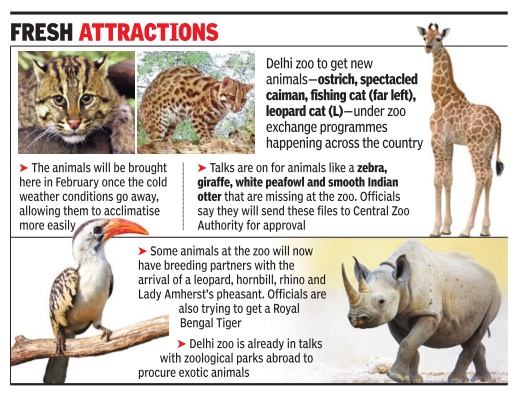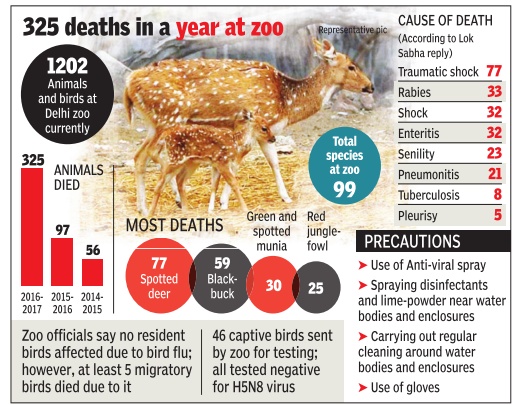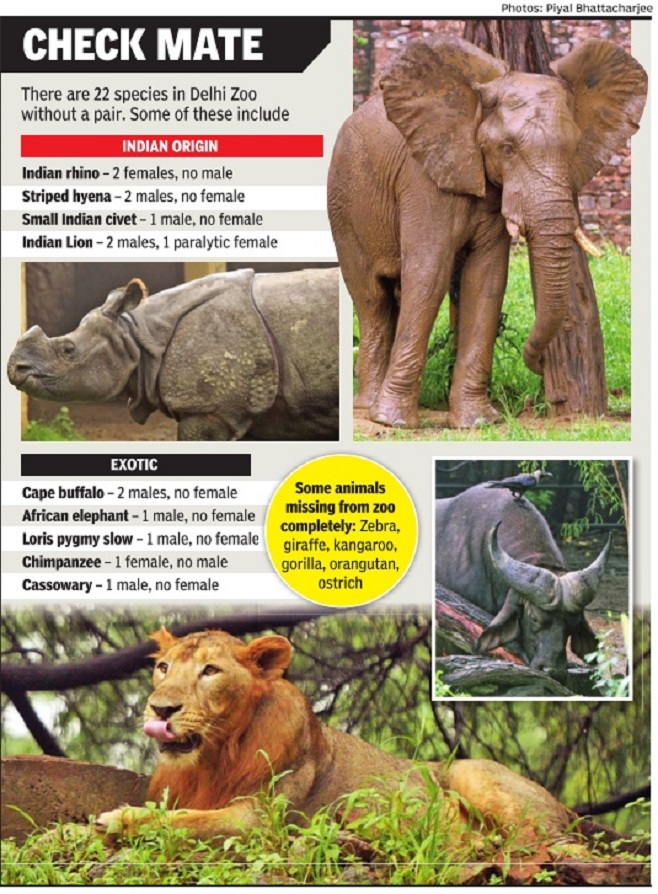Delhi Zoo
This is a collection of articles archived for the excellence of their content. |
Contents[hide] |
Zoo (National Zoological Park)
Attractions in the zoo
2017 November, animals in the zoo

From: November 7, 2017: The Times of India
See graphic:
Attractions in Delhi Zoo, November 2017
Chimpanzees
57-year-old in Record Books/ 2019
Delhi zoo’s oldest chimpanzee, 57-year-old Rita, has now been recognised as the oldest chimpanzee in the country, according to the Limca Book of Records. Rita came from Amsterdam zoo as part of an exchange of demoiselle cranes in 1964. She was inducted in the record book on Thursday, with the certificate stating, “Rita, an inmate of Delhi zoo is India’s oldest chimpanzee and probably the oldest in Asia.”
Delhi 11 zoo director Renu Singh said the zoo had applied for the certification last year and the confirmation was received earlier this month. The Limca Book of Records carried out the basic record checks across zoological parks in the country before confirming. “Most chimpanzees don’t live beyond the age of 50 with their lifespan ranging from 40 to 50 years. Rita has lived well past that and continues to flourish here,” said Singh.
Rita became a star attraction in 2017 when zoo visitors celebrated her birthday, which included a cake-cutting ceremony. Cut-outs of Rita and a large display screen had been put outside her enclosure, showcasing her each move.
Rita was paired with a male chimpanzee Max at Delhi zoo. She was loaned to Chhatbir zoo in Punjab in 1985 but returned to the Delhi zoo again in 2006.
Deaths of animals
2014-17
See graphic: Animal deaths in Delhi zoo, 2014-17, year-wise

Of the 325 deaths recorded at Delhi zoo in 2016-17, more than 100 cases were due to traumatic shock -that is, shock in captivity . Also, it was the first time in six years that over 300 animals had died in a single year.
A day after Union environment minister Harsh Vardhan informed the Lok Sabha about the high mortality, TOI did a reality check to find that unlike the previous year, rabies and bird flu weren't the biggest culprits this time. While 33 cases of rabies were reported, not a single death took place due to bird flu.
“Forty-six resident birds that died last year were sent for testing for H5N8 virus.However, all tests came out negative. We could not find out the actual cause of death as postmortem wasn't conducted at the zoo. At least five positive cases of bird flu were reported last year, but all these involved migratory birds,“ said a zoo official.
In fact, the total number of deaths recorded last year was greater than the combined figure of the three years prior to that. The zoo recorded 97 deaths in 2015-16; 56 in 2014-15; and 103 in 2013-14.
As many as 77 spotted deer deaths were recorded in 2016-17; 33 of these occurred due to rabies.
Another 59 blackbuck -a Schedule-I animal under the Widlife Protection Act, 1972 -died, several of them dying due to pneumonitis, an inflammation of lungs.
A total of 109 cases related to `traumatic' shock that, zoo officials said, might occur when the ani mal was stressed or faced with extreme weather conditions. “Animals, especially deer, often fight among themselves to show superiority. This sometimes causes shock,“ said a zoo official.
In addition, 23 deaths were reported due to senility, 32 because of enteritis, 21 due to pneumonitis and eight owing to tuberculosis.
The zoo also lost all four of its monitor lizards, which were `pulled' out during hibernation, leading to shock.An exotic African cape buffalo died due to tuberculosis.
Zoo authorities said they were taking precautions. “We are regularly cleaning the enclosures and using anti-viral spray for animals. We are using disinfectants for ponds and workers have been asked to use gloves,“ said Renu Singh, director, Delhi zoo.
Attractions in Delhi Zoo, November 2017
Footfalls
Records
Delhi zoo saw a record footfall of close to 34,500 visitors January 1, 2018 beating its previous record by over 2,000 people. Earlier, the highest footfall recorded on a single day was 32,006. Zoo officials said 34,352 visitors came to the zoo on January 1, 2018, despite foggy conditions and low mercury. In 2017, the zoo recorded a footfall of 31,414 visitors on Eid.
Monuments within the campus
Unmarked tomb
The Times of India, August 11, 2015

Little is known about the tomb, historians say it was an early Mughal-era structure, one of the many that can be found in the area. It is not a listed monument, and decades of neglect have led its ornamentation and geometric patterns to wither away completely. The masonry of the dome is exposed, with creepers trailing all over it. Many stones on the edges seem to rest loosely, ready to fall on anyone standing underneath./// The tomb is close to a black bear enclosure on a raised ground near a waterbody .While zoo authorities have installed a signboard telling visitors to keep out. It has been done in a seemingly perfunctory manner. This sole board has been placed in a corner less frequented by people, and there are no railings or barriers which ideally should have been there considering it's a crumbling building.
